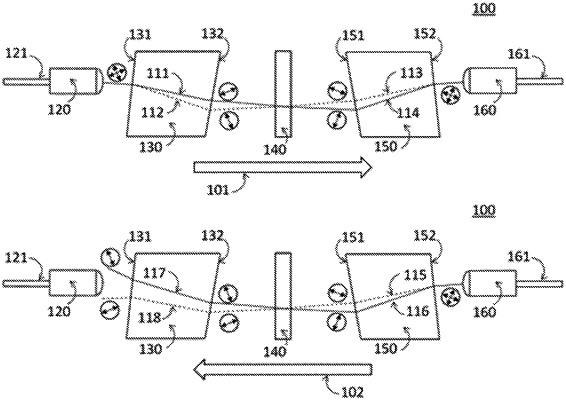| CPC G02F 1/093 (2013.01) [G02B 5/3083 (2013.01); G02B 27/283 (2013.01); G02B 27/30 (2013.01)] | 14 Claims |

|
1. An optical isolator assembly, comprising:
a first optical collimator;
a first polarization beam splitter/combiner;
a non-reciprocal polarization rotator;
a second polarization beam splitter/combiner,
a second optical collimator,
wherein, with an optical signal received in the first optical collimator in a forward direction, a first incoming collimated optical beam emerges from the first optical collimator, passes through sequentially the first polarization beam splitter/combiner, the non-reciprocal polarization rotator and the second polarization beam splitter/combiner, and exits through the second optical collimator,
wherein optical paths of two orthogonally polarized beams, an o-ray and an e-ray emerging from the first polarization beam splitter/combiner are configured to cross each other at a position, as projected on an incidence plane, before arriving at the second polarization beam splitter/combiner,
wherein, with the optical signal received in the first optical collimator in the forward direction, polarizations of the two orthogonally polarized beams, the o-ray and the e-ray emerging from the first polarization beam splitter/combiner, are configured so that the o-ray from the first polarization beam splitter/combiner turns into an e-ray in the second polarization beam splitter/combiner and the e-ray from the first polarization beam splitter/combiner turns into an o-ray in the second polarization beam splitter/combiner,
wherein, with another optical signal received in the second optical collimator in a reverse direction, a second incoming collimated optical beam from the second optical collimator passes through sequentially the second polarization beam splitter/combiner, the non-reciprocal polarization rotator and the first polarization beam splitter/combiner, and emerge as two angularly deviated orthogonally polarized beams due to the non-reciprocal polarization rotator, and
wherein the two angularly deviated orthogonally polarized beams cannot be coupled into the first optical collimator.
|